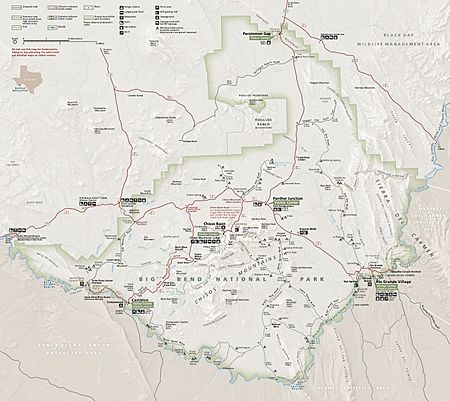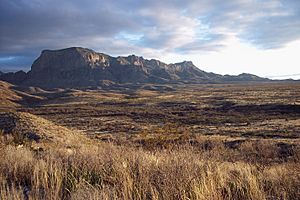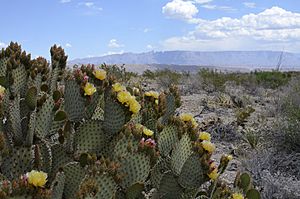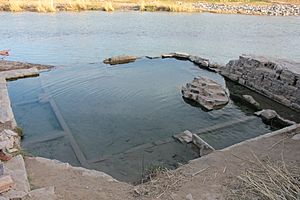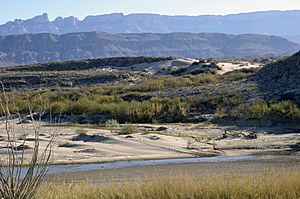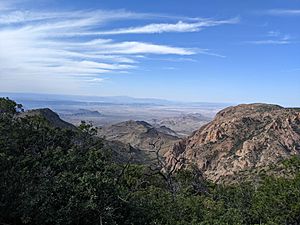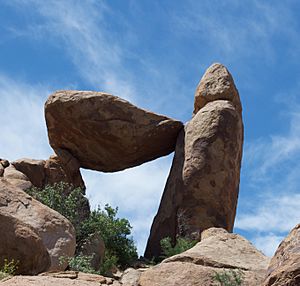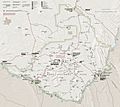Big Bend National Park facts for kids
Quick facts for kids Big Bend |
|
|---|---|
|
IUCN Category II (National Park)
|
|
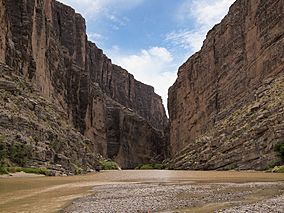
The Rio Grande runs through Cañón de Santa Elena, Mexico on the left and Big Bend National Park, U.S. on the right.
|
|
| Location | Brewster County, Texas, United States |
| Nearest city | Alpine |
| Length | 4 km (2.5 mi) |
| Area | 801,163 acres (3,242.19 km2) |
| Established | June 12, 1944 |
| Visitors | 463,832 (in 2019) |
| Operator | National Park Service |
| Website | Big Bend National Park |
Big Bend National Park is a huge national park in West Texas, right next to Mexico. It's super important because it protects the largest part of the Chihuahuan Desert in the United States. The park gets its name from a big bend in the Rio Grande river.
This amazing park is home to over 1,200 kinds of plants, more than 450 types of birds, 56 kinds of reptiles, and 75 types of mammals. You can enjoy scenic drives, join fun programs led by park rangers, and even go stargazing because the night sky here is incredibly dark.
The area has a long and interesting history. People have lived here for nearly 10,000 years! Later, pioneers, ranchers, and miners also made their homes here. The Chisos Mountains are completely inside the park, which is very unique. You can also find cool fossils like sea creatures and dinosaur bones in the park.
Big Bend National Park covers about 801,163 acres (3,242 square kilometers). The Rio Grande river forms about 118 miles (190 km) of the border between Mexico and the United States. The park manages this part of the border.
Because the Rio Grande is an international border, the park has special rules. The park's land only goes to the middle of the river channel, as it was in 1848. The rest of the river and land south of it belong to Mexico. On the Mexican side, there are also protected areas like Cañón de Santa Elena and Maderas del Carmen.
Contents
- Exploring Big Bend's Landscape and Weather
- A Look Back in Time: Big Bend's History
- The Rocks and Land of Big Bend
- Ancient and Modern People of Big Bend
- Plants and Animals of Big Bend
- Dinosaur Bones and Ancient Life
- Relaxing in Hot Springs
- Fun Things to Do in Big Bend
- Learning in the Park
- Images for kids
- See also
Exploring Big Bend's Landscape and Weather
Big Bend National Park has a very dry and hot climate. Summers can be super hot, often over 100°F (38°C) in the lower areas. Winters are usually mild, but it can get below freezing sometimes.
The park has a huge range of elevations, from about 1,800 feet (549 meters) along the river to Emory Peak in the Chisos Mountains at 7,832 feet (2,387 meters). This big difference in height means there are many different plant and animal homes. Some plants, like the Chisos oak, are found nowhere else in the United States!
The 118 miles (190 km) of the Rio Grande that form the park's southern border include amazing canyons like Santa Elena, Mariscal, and Boquillas. The river has carved deep canyons with tall, straight walls through the limestone rock. Along the river, you'll find a green area with many plants and animals, even though it's in the middle of the Chihuahuan Desert.
The Chisos Mountains in the park are like "sky islands" because they are surrounded by desert. Many unique plants and animals live in these mountains and in the desert springs scattered across the park.
South of the border in Mexico are the states of Chihuahua and Coahuila. These areas also have protected lands, like the Maderas del Carmen and the Cañón de Santa Elena.
A Look Back in Time: Big Bend's History
Before Europeans arrived, several Native American groups lived in the Big Bend area. The Chisos Indians were hunters and gatherers who moved around. They might have grown some crops too. The Jumano people also traveled and traded here.
Around the 1700s, the Mescalero Apaches came to the Big Bend region. They took over from the Chisos Indians. The Comanches also passed through the park on their way to and from Mexico. These raids continued until the mid-1800s.
Europeans first explored this area around 1535. Spanish explorers looked for gold, silver, and good land for farms and ranches. Franciscan missionaries also came to teach the native people. To protect their northern border, the Spanish built forts called presidios along the Rio Grande in the late 1700s. Some of these forts were later left empty.
After Mexico became independent from Spain in 1821, the region became part of Mexico. Mexican families lived here when English-speaking settlers started arriving in the late 1800s.
After the Mexican–American War in 1848, the U.S. Army explored the Big Bend. They built forts to protect settlers from Indian attacks. Many soldiers in the late 1800s were African Americans, known as "buffalo soldiers".
Ranchers started settling in Big Bend around 1880. By 1900, most of the area was used for sheep, goat, and cattle ranches. This caused the delicate desert environment to be overgrazed.
In the late 1800s and early 1900s, valuable minerals were found. People came to work in the mines or support them by farming. Towns like Boquillas and Terlingua grew up around these mines. Farmers also settled along the Rio Grande.
In 1916, a raid at Glenn Springs got national attention. President Wilson sent the Texas National Guard to help protect the border. A permanent army camp was set up at Glenn Springs until 1920.
How Big Bend Became a Park
In the 1930s, many people realized that Big Bend was a special place worth saving. In 1933, Texas created Texas Canyons State Park, which was later renamed Big Bend State Park. In 1935, the U.S. Congress passed a law to buy the land for a national park. Texas gave the land to the federal government. On June 12, 1944, Big Bend National Park officially opened to visitors on July 1, 1944.
The Rocks and Land of Big Bend
Big Bend's landscape tells a long story of Earth's changes. The oldest rock movements happened over 550 million years ago! These movements pushed rocks from the South American Plate over the North American Plate. You can see this in the Persimmon Gap area.
Later, the South American Plate pulled away from the North American Plate. This created a sea where layers of rock were laid down. During this time, dinosaurs, forests, and other ancient life were preserved as fossils in the park.
After the seas dried up, the Big Bend area was squeezed and pushed, forming mountains and basins. Most of the park's volcanic rocks, like the Chisos Group, formed during this time.
The most recent changes happened as the land stretched and cracked, creating valleys and mountains. The Rio Grande river entered the Big Bend area about 2 million years ago. Since then, the river has carved out the amazing canyons we see today.
Ancient and Modern People of Big Bend
The park has many cultural sites, from the time of the first people 10,500 years ago to more recent Native American groups like the Chisos, Mescaleros, and Comanche. Later, Spanish, Mexican, and Anglo settlers came to farm, ranch, and mine in the area.
For thousands of years, early humans used shelters and set up camps throughout the park. They lived a nomadic life, hunting and gathering food, which stayed pretty much the same for a very long time.
More recently, people used the river areas for farming and irrigation. You can still see old irrigation systems, simple homes, and terraced farmlands along the riverbanks.
Plants and Animals of Big Bend
Even though Big Bend is a tough desert, it has an amazing amount of life! There are over 1,200 types of plants (including 60 kinds of cactus), more than 600 types of animals with backbones, and about 3,600 types of insects. This huge variety is because the park has different environments: a dry, hot desert, cool mountains, and a fertile river valley.
Cool Plants
The many kinds of cactus and other plants add beautiful colors to Big Bend. Some cacti you might see are prickly pear, claretcup, and pitaya. In the spring, wildflowers bloom everywhere, and yucca flowers show off bright colors. Bluebonnets are common, and you might even spot white and pink ones. Other pretty flowering plants include desert marigold, desert willow, ocotillo, and lechuguilla.
The candelilla plant was very important to the region. It was used to make candelilla wax, which led to wax-making camps in the park area, like Glenn Springs.
Amazing Animals

Most animals in the desert are not active during the day. The park comes alive at night when many animals search for food. About 150 cougar sightings are reported each year, even though only about two dozen cougars live in the park.
Other animals you might find include coyotes, kangaroo rats, greater roadrunners, golden eagles, gray foxes, collared peccarys (also called javelinas), and black-tailed jackrabbits. Mexican black bears also live in the mountain areas.
There were plans to bring back the Mexican wolf to Big Bend National Park in the 1980s. However, these plans were stopped because people disagreed if there were enough prey animals, like deer and javelinas, to support a wolf population.
Birds Galore!
More than 450 types of birds have been seen at Big Bend National Park! Bird watchers love this park because it's the only place in the United States where the Colima warbler nests. This bird arrives in the Chisos Mountains in mid-April to spend the summer in the high canyons. By mid-September, it flies back to Mexico for the winter. The Colima warbler builds its nest on the ground and likes the oak-maple forests found in places like Boot Canyon.
Dinosaur Bones and Ancient Life
Big Bend National Park is a treasure trove of fossils! Scientists have been studying fossils here since 1907.
A History of Fossil Discoveries
In 1907, Johan Udden found shark and ammonite fossils. Later, in the late 1930s, people working on a project found fossils at three different sites. Famous fossil hunters like Barnum Brown and Roland “R.T.” Bird came in 1940 looking for dinosaur remains. They found neck bones of a giant long-necked dinosaur called Alamosaurus and jawbones of a huge crocodile-like animal called Deinosuchus.
The first museum built to show fossils at the park burned down in 1941, and valuable mammoth teeth and saber-toothed cat fossils were lost. A new fossil exhibit opened in 1957, showing fossils of Hyracotherium, an early horse ancestor, and Coryphodon, a large hippo-like animal that lived about 55 million years ago. Today, if you want to collect fossils in Big Bend National Park, you need a special permit.
What Big Bend Was Like Long Ago
Big Bend Underwater (135 million years ago)
Imagine Big Bend covered by water! Fossils from this time include sharks, marine reptiles like plesiosaurs, and tiny sea creatures. Fossils from 85–82 million years ago show that warm waters covered Big Bend, with sharks, small mosasaurs, and fish like Xiphactinus. Spiral-shelled ammonites are also common.
Big Bend Delta (83–72 million years ago)
When the water levels dropped, Big Bend became a mix of deltas, like river mouths. Fish, sharks, big turtles, and crocodile-like animals lived here. There's also proof of land animals like herds of hadrosaurs (duck-billed dinosaurs), horned ceratopsids, armored nodosaurs, and tyrannosauroids (like T-Rex).
The Javelina Formation (72–67 million years ago)
At this time, Big Bend was completely above sea level. Some animals here included early meat-eating mammals, hadrosaurs, ceratopsians, tyrannosauroids, and the largest known flying reptile, Quetzalcoatlus. The rivers and streams were full of fish, rays, and amphibians.
Black Peaks Formation (67–66 million years ago)
In the rock layers from the end of the Cretaceous period, scientists have found fossils of flowering plants, conifer trees, fish, rays, and the bones of Alamosaurus. The Cretaceous-Paleogene (K-Pg) extinction event happened around 66 million years ago. This huge event wiped out 70% of life on land, including all non-bird dinosaurs and pterosaurs, and 90% of ocean life.
Relaxing in Hot Springs
Big Bend has several hot springs, especially in the Hot Springs Historic District. The main one is just called Hot Springs. It's also known as Bocadillas hot springs or Langford hot springs. This hot spring is listed on the National Register of Historic Places.
The hot springs were the first big tourist attraction in the Big Bend area, even before it became a national park. In 1909, J.O. Langford started to develop the springs. There was an old stone soaking tub already there. The Langford family built a house, a stone bathhouse, and shelters for bathing. Later, in 1927, they rebuilt the bathhouse and added a store and cabins for visitors.
Fun Things to Do in Big Bend
Big Bend is one of the largest and most remote national parks in the United States. It's also one of the least visited, making it a great place to find peace and quiet. Each year, about 377,154 people visit the park.
The best way to explore Big Bend is by hiking and backpacking. Some popular trails include:
- The Chimneys Trail, which leads to a cool rock formation.
- The Marufo Vega trail, a loop that goes through beautiful canyons to the Rio Grande.
- The South Rim trail, which circles the high Chisos Mountains.
- The Outer Mountain Loop trail in the Chisos, a challenging 30-mile (48 km) loop.
Other cool spots to visit are Santa Elena Canyon, Grapevine Hills, and the Mule Ears, which are two tall rock towers in the desert. You can even hire guides for backpacking trips.
The park also manages 118 miles (190 km) of the Rio Grande for fun activities. You can take a boat tour with professional guides or use your own boat (you'll need a free permit). Since 2009, if you float down the river, you need a passport or other ID to re-enter the U.S.
Many visitors cross the Rio Grande to visit the Mexican village of Boquillas. The border crossing was closed after 9/11 but reopened in April 2013. It's now an official entry point between the U.S. and Mexico, open Wednesday through Sunday.
With over 450 types of birds, birdwatching is a very popular activity. Many bird species stop in the park during their yearly migrations.
There are five paved roads in Big Bend:
- Persimmon Gap to Panther Junction: A 28-mile (45 km) road from the north entrance to the park headquarters.
- Panther Junction to Rio Grande Village: A 21-mile (34 km) road that goes down 2,000 feet (610 m) to the Rio Grande.
- Maverick Entrance Station to Panther Junction: A 23-mile (37 km) route from the western entrance to park headquarters.
- Chisos Basin Road: A 6-mile (9.7 km) road that climbs to 5,679 feet (1,731 m) before going down into the Chisos Basin.
- Ross Maxwell Scenic Drive: A 30-mile (48 km) drive that leads to the Castolon Historic District and Santa Elena Canyon.
A Park for Stargazing
In 2012, Big Bend was named an international dark-sky park. This means it's one of the best places in the world to see the night sky, with very little light pollution. Measurements show that Big Bend has the darkest skies in the contiguous United States. On clear nights, you can see thousands of stars, bright planets, and the amazing Milky Way galaxy!
Learning in the Park
The San Vicente Independent School District is located within the park. Its school moved to the Panther Junction area around 1951 so children of park employees could go to a local school. Most of the park is in San Vicente ISD. High school students from San Vicente ISD attend Big Bend High School in the Terlingua Common School District.
Images for kids
See also
 In Spanish: Parque nacional Big Bend para niños
In Spanish: Parque nacional Big Bend para niños
- List of national parks of the United States
- List of birds of Big Bend National Park
- Big Bend
- Big Bend Ranch State Park
- Chihuahuan Desert
- Chisos Mountains
- Guadalupe Mountains
- Marathon, Texas
- Mexico–United States international park
- McKittrick Canyon
- Pecos River
- Rio Grande Wild and Scenic River
- Terlingua, Texas
- Trans-Pecos
- West Texas




